The Ultimate BCD Shopping Guide

So you’re shopping for a BCD…
There are many benefits to owning your own scuba gear, but some of the most important reasons are the fit and the features. Owning your own gear lets you pick gear that fits you perfectly and has all the features you want. Whether you are a seasoned diver looking to replace your old trusty BCD or a newer diver thinking about making an investment into owing your first BCD, there are some important things to consider when you are shopping around.
If you really want to get the BCD that is best for you, you should start by thinking about the types of diving you will be doing and the conditions you will be diving in. A lot of guides will take you straight into picking this feature vs. that feature or this brand vs. that brand. If you aren’t clear on how you’re going to use it, how will you know which BCD or features are best?
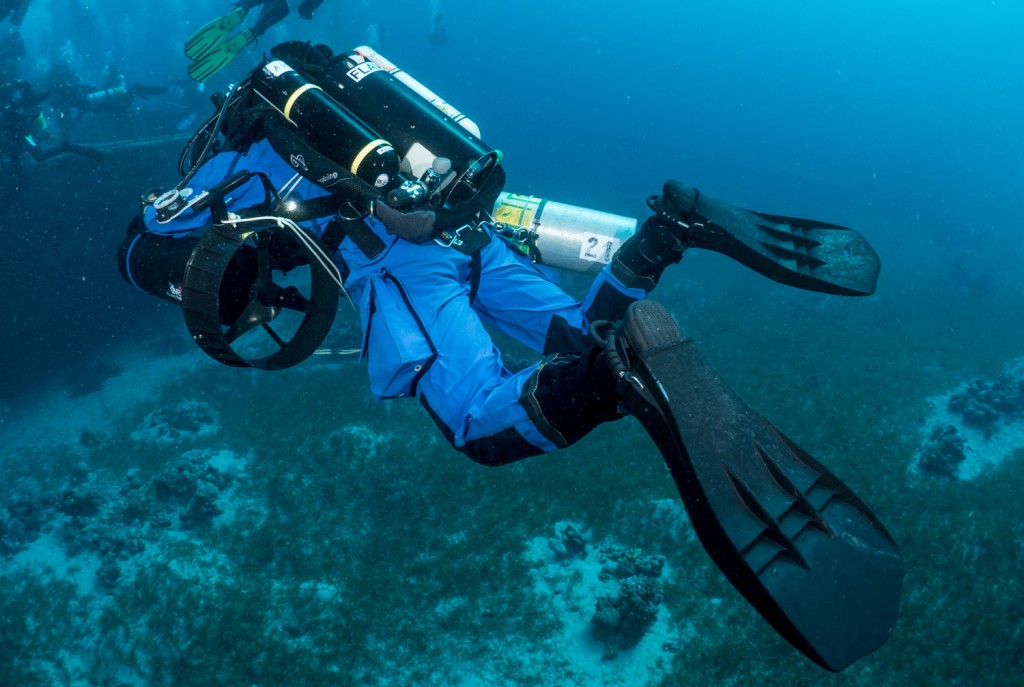
Here are a few questions to ask yourself as you start shopping:
- Do you dive in clear, warm water or cold northern lakes? If you will be diving in warmer waters, you will almost certainly be wearing less exposure protection. However, in colder waters you might be diving a dry suit or layers of wetsuits. As much as a lot of us would love nothing more than diving the Caribbean all the time, there are some of us out there (myself included) who like to dive in the colder waters of higher altitude lakes and sometimes even under the ice in the winter.
- Do you travel often or do you usually dive at local dive sites? If you do a lot of traveling, BCD size and weight will be much more of an issue than if you spend most of your time diving locally. Nobody likes paying more in airline luggage fees!
- Are you doing dives that are gear-intensive, like underwater photography, night diving, or search and recovery? All that gear should be tethered to something or stowed, and you’ll need a bit of extra buoyancy to lift all that equipment. Having pockets and D rings to tether and store gear will help keep you streamlined and stay organized.
- If you are a female diver, do you find yourself having a difficult time locating a BCD that fits your anatomy? There are BCDs now that are designed specifically for women, and these can really make a big difference in your comfort while diving.
Now that you’ve made a few decisions about what the main characteristics of your diving are going to be, let’s get started!
The two most important features of a BCD are fit and reliability. If a BCD doesn’t fit properly, it won’t be stable in the water and you’ll use more air inflating and deflating it as you try to achieve neutral buoyancy. If your trim is off, you will have to work harder to swim and you’ll use more air that way. The better your air consumption is, the longer your dives can be! Since I assume one of the main reasons you’re buying your own gear is to do more diving, this is definitely moving in the right direction!

If a BCD is not reliable, it is not safe. Bottom line, you need to be able to trust your equipment with your life. The major manufacturers today take great pride in the durability and reliability of their equipment, and many offer excellent warranties. However, be cautious of buying from sites or stores that are not authorized retailers of the equipment they sell. They are known as “grey market” retailers, and buying from one will often void the warranty on your new gear. Aqua Lung and Apeks, Tusa, Zeagle, ScubaPro, Mares, Cressi, Hollis, and Sherwood are all manufacturers that have a history of making great gear.
Design
Since the purpose of the BCD is to let you control your buoyancy, let’s start by looking at the different designs of the BCD bladders. The three main styles are jacket BCDs, where the entire BCD inflates; back (or wing) inflate, where a separate bladder only on the back fills with air; and hybrids, where there is some inflation in the body but most is on the back. There is a final option of a backplate and wing, which is a harness attached to a rigid backplate that you build to suit your particular needs; this is very popular with technical divers and other advanced divers, but is not necessarily a good option for a beginner without instruction in proper setup. Dive Rite, Halcyon, and Hollis make a variety of wings and backplates, but you should definitely talk to your local dive instructors or shop staff, or start looking here for more info on this setup. Look for an article in the future all about the many options, benefits, and configurations for backplate and wing setups.
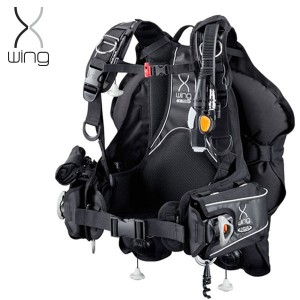
Jacket BCDs tighten around you as you inflate them, so if you like a more open feel and less constriction you will want to consider a back inflate or hybrid. Since a back inflate BCD has the bladder separate from the harness system, you won’t get squeezed as you fill the BCD. These BCDs usually have a higher lift capacity. One good feature to look for on back inflate BCDs is a retraction system of some kind for the bladder. The retraction system will use bungee cord or a similar material to squeeze the bladder as it fills and deflates, keeping the cross section as small as possible to reduce drag. Although back inflate BCDs tend to naturally streamline you horizontally while you are in the water, at the surface they will push you face forward and may require more effort to float upright. Hybrids are a compromise between the jacket and back inflate styles; they have a lot of the streamlining ability and trim of the back inflate but also have some buoyancy in front to balance you out. A great feature to have on all of these styles of BCDs is a rear lower exhaust valve. Located on the lower corner of the bladder near your hips, the rear exhaust valve will allow you to let air out of the BCD without moving out of your horizontal trim position.

You may have seen BCDs labeled as “sidemount”. What does this mean? Sidemount is a system of rigging your tanks and other equipment on the sides of your body rather than having your tank on your back. There are some big benefits to diving sidemount, and you can read about them here. In the same vein as backplates and wings, there is additional training and knowledge you’ll need to use this configuration safely, so consult your local dive shop and dive professionals for more info.
The rear exhaust valve brings up the next consideration: inflation and deflation. All BCDs have an inflator valve that connects to the first stage of your regulator to add and release air, and an oral inflation mouthpiece as a backup. The designs of these vary from model to model and manufacturer to manufacturer, so make sure to familiarize yourself with the operation of the inflator you are looking at BEFORE you dive. Some inflators offer a secondary regulator built into the BCD inflator hose, or divers add them as an aftermarket mod, like the Atomic SS1 or the Scubapro Air2. The functionality and dive procedures for sharing air with this design are topics of hot debate, and you will want to do some more research on ScubaBoard or other forums online. Personally, I like having a third backup regulator after my primary and octopus; I always like to have at least two solutions to any foreseeable problem.
Lift
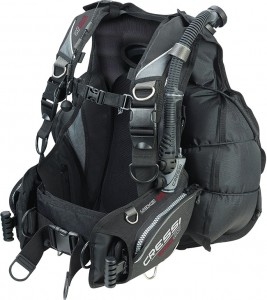 Now that we have talked about where the BCD stores air, and how it gets air in and out, we should take a minute to talk about lift capacity. This is the amount of buoyancy your BCD bladder provides when fully inflated, measured in pounds (or newtons). Smaller BCDs are going to have smaller lift capacities just due to their size, and back inflate or backplate and wing designs are going to generally have higher lift capacities, especially if you are adding larger aftermarket wings. You need to make ABSOLUTELY sure that the BCD you choose has enough lift capacity to give you positive buoyancy if needed, as well as maintain your neutral buoyancy during the dive. Another thing to remember is that as you use your air, your buoyancy will change throughout the dive. The amount of gear you carry, what kind of tanks you are diving (steel vs. aluminum, LP vs. HP), and what exposure protection you are wearing (drysuit vs. wetsuits) will all affect your buoyancy and weighting. As a safety measure, it is also a good idea to have extra lift available in your BCD in case your drysuit floods. You can usually find the buoyancy characteristics of most dive equipment in the manufacturer’s descriptions. If all of this sounds confusing, don’t worry! Your local dive pros will help you figure all of this out, and while the math is available on several scuba forums it is not as complicated as it sounds. The small amount of time you’ll spend before the dive figuring out your buoyancy, weighting, and trim will pay off as less effort while diving and using less air maintaining your buoyancy.
Now that we have talked about where the BCD stores air, and how it gets air in and out, we should take a minute to talk about lift capacity. This is the amount of buoyancy your BCD bladder provides when fully inflated, measured in pounds (or newtons). Smaller BCDs are going to have smaller lift capacities just due to their size, and back inflate or backplate and wing designs are going to generally have higher lift capacities, especially if you are adding larger aftermarket wings. You need to make ABSOLUTELY sure that the BCD you choose has enough lift capacity to give you positive buoyancy if needed, as well as maintain your neutral buoyancy during the dive. Another thing to remember is that as you use your air, your buoyancy will change throughout the dive. The amount of gear you carry, what kind of tanks you are diving (steel vs. aluminum, LP vs. HP), and what exposure protection you are wearing (drysuit vs. wetsuits) will all affect your buoyancy and weighting. As a safety measure, it is also a good idea to have extra lift available in your BCD in case your drysuit floods. You can usually find the buoyancy characteristics of most dive equipment in the manufacturer’s descriptions. If all of this sounds confusing, don’t worry! Your local dive pros will help you figure all of this out, and while the math is available on several scuba forums it is not as complicated as it sounds. The small amount of time you’ll spend before the dive figuring out your buoyancy, weighting, and trim will pay off as less effort while diving and using less air maintaining your buoyancy.
Weights
Weight integration is the next big feature. Some BCDs come with an integrated weight system, which means depending on how much weight you need you may not have to wear a separate weight belt. Sound awesome? That’s because it is! These systems have special pockets or pouches that are designed to carry weights but are able to be quickly ditched in an emergency. There are different designs for these quick-releases, like the zip-cord style of the Zeagle as opposed to the mechanical latch of the Mares Dragon and most other manufacturers’ BCDs. I would advise against Velcro based quick-release systems for two reasons: the Velcro will lose its adhering strength over time, and this type of release is easy to accidentally release, creating a dangerous underweighted situation. You do need to look at how much weight the system will carry, as some integrated weight systems have smaller capacities than a normal weight belt. If you are diving dry, you may have to split the difference between a weight belt and the integrated weight system. A lot of BCDs will also have trim pockets, where you can put smaller weights to balance your trim and help you streamline. These pockets are not easily detachable in an emergency, so you will need to make sure that a majority of your weight is stored in the main part of the integrated weight system. Manufacturers are moving more and more towards this type of system on a lot of BCDs, so you will find this to be more common than it was a few years ago.
The amount of exposure protection that you wear will affect both your BCD fit and your buoyancy. If you are normally right on the edge between one size and the next, then stepping up to drysuit diving or diving with thick wetsuit layers will require extra room, and thus a bigger size, for the BCD to fit properly. When you are looking at fit, look at the way the BCD attaches to your body. Does it have a Velcro cummerbund or just a waist strap? Are the shoulder straps wide enough to be comfortable in and out of the water (where you are carrying the full brunt of your tank and weights)? Does the sternum strap keep the shoulder straps in proper position? How do the straps and waist band adjust; namely, do they stay secure once adjusted, and are you able to adjust them easily? These are all questions that you can really only answer by trying on gear in person at your local dive shop, where the staff will (as usual) be able to help you find a BCD that fits you well. Women, do not fear! The BCDs I was talking about earlier that are made specifically for you have just as many features as the non-gender specific ones and are just as rugged and reliable. The ScubaPro Ladyhawk is a great example of this; it is identical to the ScubaPro Knighthawk except the female-specific anatomical design.
Mounts and pockets
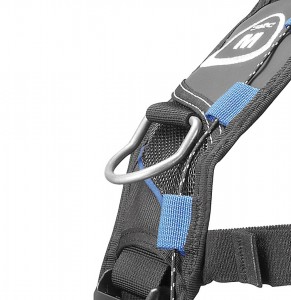 Ok, we are getting a lot closer to finding the perfect BCD for you, we only a few things left to go over (I promise). Now that you have the BCD design and size that will suit your type of diving, the lift capacity you need for you and your gear, and you are ready to go with your inflator (and inline regulator if you like), the next question is: where are you going to put your dive tools and equipment? There are two ways to approach this: D-rings and pockets. D-rings are great for attaching small pieces of gear like flashlights for night diving, knives or other cutting tools, slates for communication, and perhaps a compass or something similar. A detail to look at here is the design of the D-ring. Most D-rings will lay flat against the BCD when not in use; the best ones in my opinion have a slight bend to them so they protrude away from the strap they are attached to. This bend lets you find and clip gear to the D-ring much more easily. Look at this BCD for an example of the bent D-ring design. For clipping gear to D-rings, I always use bolt snaps. They are secure once fastened, do not easily come open and tend not to tangle in lines or other filament, and can stand up to the rigors of fresh and salt water. Here are a variety of bolt snaps to get you started. Retractors are also great for keeping gear close at hand. There is a tutorial all about how to safely stow and connect gear to yourself in another article. Pockets are also useful for stowing small gear that does not have a way to clip to a D-ring, like notebooks or pocket masks. The main thing to remember is one of the main themes I have been talking about throughout the article: streamline, streamline, streamline! If you have lots of gear dangling from every D-ring, you are going to have more drag in the water and swimming will require more effort. You will also have a higher likelihood of catching or dragging your gear against the bottom or anything else you swim close to. Consider whether you really need those items before you take them on each dive.
Ok, we are getting a lot closer to finding the perfect BCD for you, we only a few things left to go over (I promise). Now that you have the BCD design and size that will suit your type of diving, the lift capacity you need for you and your gear, and you are ready to go with your inflator (and inline regulator if you like), the next question is: where are you going to put your dive tools and equipment? There are two ways to approach this: D-rings and pockets. D-rings are great for attaching small pieces of gear like flashlights for night diving, knives or other cutting tools, slates for communication, and perhaps a compass or something similar. A detail to look at here is the design of the D-ring. Most D-rings will lay flat against the BCD when not in use; the best ones in my opinion have a slight bend to them so they protrude away from the strap they are attached to. This bend lets you find and clip gear to the D-ring much more easily. Look at this BCD for an example of the bent D-ring design. For clipping gear to D-rings, I always use bolt snaps. They are secure once fastened, do not easily come open and tend not to tangle in lines or other filament, and can stand up to the rigors of fresh and salt water. Here are a variety of bolt snaps to get you started. Retractors are also great for keeping gear close at hand. There is a tutorial all about how to safely stow and connect gear to yourself in another article. Pockets are also useful for stowing small gear that does not have a way to clip to a D-ring, like notebooks or pocket masks. The main thing to remember is one of the main themes I have been talking about throughout the article: streamline, streamline, streamline! If you have lots of gear dangling from every D-ring, you are going to have more drag in the water and swimming will require more effort. You will also have a higher likelihood of catching or dragging your gear against the bottom or anything else you swim close to. Consider whether you really need those items before you take them on each dive.
Travel
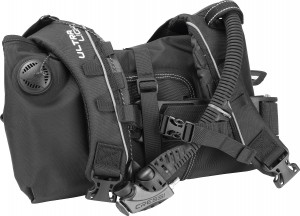 Travel BCDs have some general design features that set them apart from other BCD setups. They are usually much lighter and more compressible than standard BCDs. What do I mean by more compressible? They are minimalist in design with less bulk, and are easier to pack into your luggage as they take up less space. However, the trade off for less weight and less volume is usually less pockets, less D-rings, and possibly no weight integration ability. Take a look at this ScubaPro Litehawk for a better idea of what I’m talking about. The lack of weight integration should usually not be a problem at almost every dive shop around the world, weight belts, tanks, and regulators are pretty much standard issue. You will have to weigh what you have learned about BCD features against what you are willing to sacrifice for space and ease of packing.
Travel BCDs have some general design features that set them apart from other BCD setups. They are usually much lighter and more compressible than standard BCDs. What do I mean by more compressible? They are minimalist in design with less bulk, and are easier to pack into your luggage as they take up less space. However, the trade off for less weight and less volume is usually less pockets, less D-rings, and possibly no weight integration ability. Take a look at this ScubaPro Litehawk for a better idea of what I’m talking about. The lack of weight integration should usually not be a problem at almost every dive shop around the world, weight belts, tanks, and regulators are pretty much standard issue. You will have to weigh what you have learned about BCD features against what you are willing to sacrifice for space and ease of packing.
So, in conclusion, here are the main points we have gone over to use while for shopping for the perfect BCD:
- Figure out what kind of diving you will be doing and use that to guide you
- Jacket vs. back inflate vs. hybrid; there is a tradeoff between fit, trim characteristics, and lift capacity
- What about side mount or backplate and wing? Take some classes and talk to your local dive professionals
- Inflators: know before you go!
- How much lift capacity do you need? Read: how much are you lifting with your BCD?
- Weight integration: ease of use vs. safety and reliability; how much weight are you bringing?
- How does it fit? No such thing as too many questions here!
- How will you attach your stuff? D-rings vs. pockets, and get some bolt snaps! Retractors are nice to have too…
- Travel BCDs: weight and space vs. features; is it worth the extra luggage fees?
I hope that this guide helps you have a pleasurable experience while shopping for your new BCD, and that you use this knowledge to get the perfect one for you. Safe diving!
-James Navarre Nation, PADI MSDT #263367
- Full Guide to Snorkels and Masks – September 22, 2016
- The Ultimate BCD Shopping Guide – May 15, 2016

 CAD
CAD